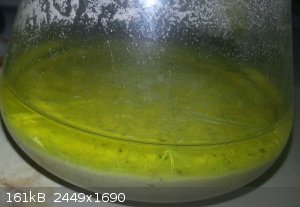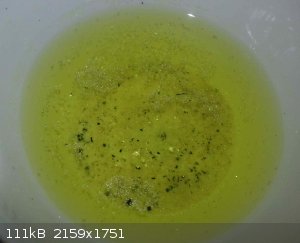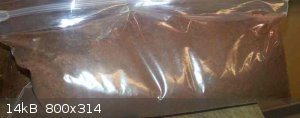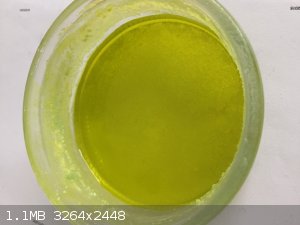RogueRose
International Hazard
    
Posts: 1585
Registered: 16-6-2014
Member Is Offline
|
|
PbCl2 from red/brown lead oxide and HCl
I had a substance I had not labeled and I thought it was Fe2O3 and if not it was a lead oxide but before I tested it I added some HCl to see how it
would react.
The redish/brownish powder turned into an off-white powder and the HCl turned yellow. Small clear or whitish crystals were formed on the surface of
the white powder and some were nice needle-like shape.
During the reaction bubbles were omitted (O2 I suspect) and the white powder was "burping" with eh buildup of gases in the heavy powder.
I understand what the crystals are, probably PbCl2, but I'm not so sure what the remaining powder on the bottom of the beaker is - possibly just
unreacted lead oxide?
In the first picture, there is a 1:2 ratio (weight) of lead oxide to 31.45% HCl which I know isn't enough HCl to convert all the oxide - as I wanted
to see what happened when there wasn't full conversion.
The lead oxide was sourced from old lead acid batteries so I guess there are some other metals mixed in, probably to a small degree.
  
|
|
|
LearnedAmateur
National Hazard
   
Posts: 513
Registered: 30-3-2017
Location: Somewhere in the UK
Member Is Offline
Mood: Free Radical
|
|
The red is definitely from Fe2O3, I've prepared FeCl3 solution (via Fe2(SO4)3 and NaCl) and it is that exact yellow colour.
Fe2O3 + 6 HCl -> 2 FeCl3 + 3 H2O
I have my doubts about it being O2 gas, lower oxides react with acid to form the salt and water, oxygen gets used up reacting with the acidic protons.
My hunch is that there was some PbO2 in the powder which reacted to form PbCl2 (the insoluble white crystals), through the equation PbO2 + 4 HCl ->
PbCl2 + 2 H2O + Cl2.
As for the rest of the white mass, I can't be of much use with that - can you check the pH of the solution to see if there is any HCl present? If so,
then it will likely be PbCl2, if it is near neutral then it would be mostly unreacted PbO. Hopefully someone with more experience in lead chemistry
can help out here.
[Edited on 9-5-2017 by LearnedAmateur]
|
|
|
RogueRose
International Hazard
    
Posts: 1585
Registered: 16-6-2014
Member Is Offline
|
|
Quote: Originally posted by LearnedAmateur  | The red is definitely from Fe2O3, I've prepared FeCl3 solution (via Fe2(SO4)3 and NaCl) and it is that exact yellow colour.
Fe2O3 + 6 HCl -> 2 FeCl3 + 3 H2O
I have my doubts about it being O2 gas, lower oxides react with acid to form the salt and water, oxygen gets used up reacting with the acidic protons.
My hunch is that there was some PbO2 in the powder which reacted to form PbCl2 (the insoluble white crystals), through the equation PbO2 + 4 HCl ->
PbCl2 + 2 H2O + Cl2.
As for the rest of the white mass, I can't be of much use with that - can you check the pH of the solution to see if there is any HCl present? If so,
then it will likely be PbCl2, if it is near neutral then it would be mostly unreacted PbO. Hopefully someone with more experience in lead chemistry
can help out here.
[Edited on 9-5-2017 by LearnedAmateur] |
That picture of the brown powder is definately lead oxide, not iron though it has a similar color. I weighed identical sample volumes of my known
rust and this and the iron weighed 3.65g while the lead weighed 11.37g for the same volume. The only place it could have come from was an old SLA
(UPS battery backup) but it was put in an old container which had been used for Fe2O3 and had that writing on the side (it was thoroughly cleaned
before adding the lead). It is just coincidence that it has nearly identical color.
IDK about the gas emitted - that really isn't a bid factor atm..
I think that is a good suggstion about it being PbO as it has a similar color.
I'll do some Ph testing but I have a feeling that the HCl has fully reacted but i'll add some heat and see if anything happens as well.
Thanks for your response!
[Edited on 9-5-2017 by RogueRose]
[Edited on 9-5-2017 by RogueRose]
|
|
|
LearnedAmateur
National Hazard
   
Posts: 513
Registered: 30-3-2017
Location: Somewhere in the UK
Member Is Offline
Mood: Free Radical
|
|
Sorry, what I meant was Fe2O3 contamination, soluble lead compounds are colourless when hydrated/in solution - even small amounts of Fe3+ produce a
yellow tinge (the image is of my FeCl3 solution), and the only yellow lead compound I can think of is PbI2, which is insoluble in water. According to
Wikipedia and images, PbO is white whereas PbO2 is black, although it can be red-brown which I suspect is the majority of the colour, but I wouldn't
rule out small amounts of Fe3+ especially since lead-acid batteries have iron based components.
Thinking about it, your white solid would certainly contain some amount of PbSO4 - whether it is the majority or only a minor component only you can
figure that out; heating the powder under a solution of potassium nitrate should cause the sulfate to dissolve, as lead nitrate is soluble and is
formed via the reaction PbSO4 + 2 KNO3 -> Pb(NO3)2 + K2SO4. PbO will not react with KNO3, as KNO3 is the thermodynamically favourable product.
[Edited on 9-5-2017 by LearnedAmateur]

|
|
|